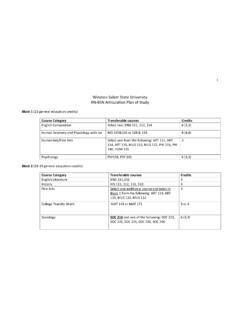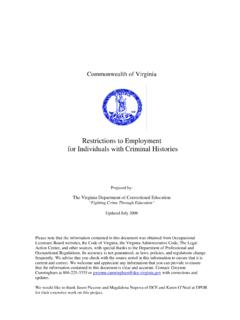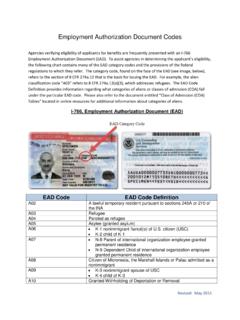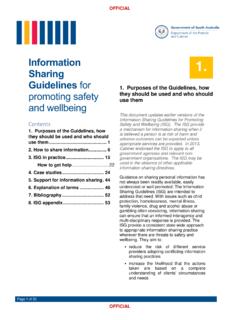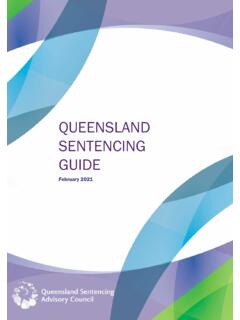Transcription of Key Elements of a Research Proposal - Quantitative Design
1 Key Elements of a Research Proposal Quantitative Design What are the main types of Quantitative approaches to Research ? It is easier to understand the different types of Quantitative Research designs if you consider how the researcher designs for control of the variables in the investigation. If the researcher views Quantitative Design as a continuum, one end of the range represents a Design where the variables are not controlled at all and only observed. Connections amongst variable are only described. At the other end of the spectrum, however, are designs which include a very close control of variables, and relationships amongst those variables are clearly established. In the middle, with experiment Design moving from one type to the other, is a range which blends those two extremes together. There are four main types of Quantitative Research : Descriptive, Correlational, Causal-Comparative/Quasi-Experimental, and Experimental Research . Types of Quantitative Design Descriptive Research seeks to describe the current status of an identified variable.
2 These Research projects are designed to provide systematic information about a phenomenon. The researcher does not usually begin with an hypothesis, but is likely to develop one after collecting data. The analysis and synthesis of the data provide the test of the hypothesis. Systematic collection of information requires careful selection of the units studied and careful measurement of Correlational Research attempts to determine the extent of a relationship between two or more variables using statistical data. In this type of Design , relationships between and among a number of facts are sought and interpreted. This type of Research will recognize trends and patterns in data, but it does not go so far in its analysis to prove causes for these observed patterns. Cause and effect is not the basis of this type of observational Research . The data, relationships, and distributions of variables Causal-comparative/quasi-experimental Research attempts to establish cause-effect relationships among the variables.
3 These types of Design are very similar to true experiments, but with some key differences. An independent variable is identified but not manipulated by the experimenter, and effects of the independent variable on the dependent variable are measured. The researcher does not randomly assign groups and must use ones that are naturally formed or pre-existing groups. Identified control groups exposed to the treatment Experimental Research , often called true experimentation, uses the scientific method to establish the cause-effect relationship among a group of variables that make up a study. The true experiment is often thought of as a laboratory study, but this is not always the case; a laboratory setting has nothing to do with it. A true experiment is any study where an effort is made to identify and impose control over all other variables except one. An independent variable is manipulated to determine the effects on the dependent variables. Subjects are randomly assigned to each variable.
4 Examples of Descriptive Research : A description of how second-grade students spend their time during summer vacation A description of the tobacco use habits of teenagers A description of how parents feel about the twelve-month school year A description of the attitudes of scientists regarding global warming A description of the kinds of physical activities that typically occur in nursing homes, and how frequently each occurs A description of the extent to which elementary teachers use math manipulatives are studied only. Variables are not manipulated; they are only identified and are studied as they occur in a natural setting. *Sometimes correlational Research is considered a type of descriptive Research , and not as its own type of Research , as no variables are manipulated in the study. Examples of Correlational Research : The relationship between intelligence and self-esteem The relationship between diet and anxiety The relationship between an aptitude test and success in an algebra course The relationship between ACT scores and the freshman grades The relationships between the types of activities used in math classrooms and student achievement The covariance of smoking and lung disease variable are studied and compared to groups who are not.
5 When analyses and conclusions are made, determining causes must be done carefully, as other variables, both known and unknown, could still affect the outcome. A causal-comparative designed study, described in a New York Times article, "The Case for $320,00 Kindergarten Teachers," illustrates how causation must be thoroughly assessed before firm relationships amongst variables can be made. Examples of Correlational Research : The effect of preschool attendance on social maturity at the end of the first grade The effect of taking multivitamins on a students school absenteeism The effect of gender on algebra achievement The effect of part-time employment on the achievement of high school students The effect of magnet school participation on student attitude The effect of age on lung capacity experimental treatments rather than identified in naturally occurring groups Examples of Experimental Research : The effect of a new treatment plan on breast cancer The effect of positive reinforcement on attitude toward school The effect of teaching with a cooperative group strategy or a traditional lecture approach on students achievement The effect of a systematic preparation and support system on children who were scheduled for surgery on the amount of psychological upset and cooperation A comparison of the effect of personalized instruction vs.
6 Traditional instruction on computational skill What is the basic methodology for a Quantitative Research Design ? The overall structure for a Quantitative Design is based in the scientific method. It uses deductive reasoning, where the researcher forms an hypothesis, collects data in an investigation of the problem, and then uses the data from the investigation, after analysis is made and conclusions are shared, to prove the hypotheses not false or false. The basic procedure of a Quantitative Design is: 1. Make your observations about something that is unknown, unexplained, or new. Investigate current theory surrounding your problem or issue. 2. Hypothesize an explanation for those observations. 3. Make a prediction of outcomes based on your hypotheses. Formulate a plan to test your prediction. 4. Collect and process your data. If your prediction was correct, go to step 5. If not, the hypothesis has been proven false. Return to step 2 to form a new hypothesis based on your new knowledge.
7 5. Verify your findings. Make your final conclusions. Present your findings in an appropriate form for your audience.


